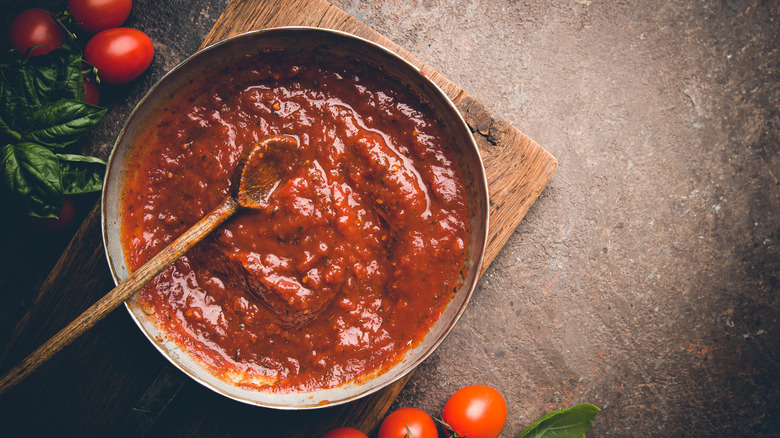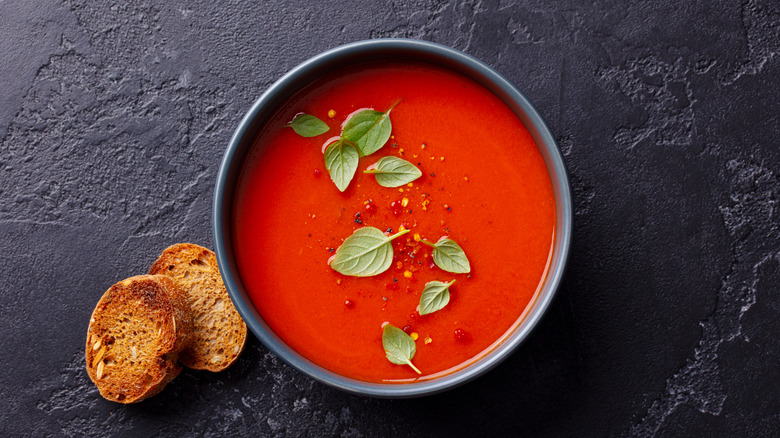The 8 Best Substitutes For Tomato Paste
Tomato paste is one of those ingredients that works well in a lot of dishes, so having it on hand is a great way to make cooking easier. However, everyone has had that moment when they go to get an ingredient, only to discover they are out of it. When this happens, instead of panicking, you can use what you already have in the pantry.
But first, let's cover what tomato paste actually is: Essentially a tomato concentrate, Chefsteps explains the ingredient is made by simply cooking tomatoes down (sans skins and seeds) until the mixture turns into a thick paste. Dark red in color, tomato paste also goes by the name tomato puree in the U.K., though the outlet cautions that this name does not translate to the U.S., where tomato puree is a decidedly different product. Another name you might find tomato paste sold under? Tomato concentrate (for obvious reasons).
If used correctly, tomato paste can add a rich flavor to sauces. While you might consider making it yourself, it's not possible in a pinch — this recipe from The Kitchn calls for 10 pounds of tomatoes and over 3 hours worth of cooking. That's a lot of work, so let's consider these substitutes instead.
1. Tomato Sauce
The best ingredient to substitute for tomato paste depends on the type of dish you're making. If the dish needs a tomato flavor, but doesn't require the thickening that tomato paste provides, tomato sauce works great as a substitute.
Keep in mind that, in addition to being thinner, tomato sauce is also less concentrated than tomato paste. As a result, to get the same tomato flavor, it will be necessary to add at least twice as much. For every tablespoon of tomato paste, Taste of Home recommends using 2 to 3 tablespoons of tomato sauce.
If your recipe calls for a large amount of paste, simmer your sauce first in order to reduce it. Recipes that this substitution would be great for are ones that only need a little tomato flavor, like butter chicken.
2. Tomato Puree
Tomato puree is a little bit thicker than tomato sauce, which is why it would work well as a substitute for tomato paste. We know what you're thinking: isn't tomato puree the same as tomato paste? The answer is no (unless you're in the U.K., then it's maybe), because puree is a canned sauce made of boiled and strained tomatoes (via A Couple Cooks). Paste is basically just more concentrated and thick.
You will get the most out of your tomato puree substitute by cooking it down to a thicker consistency and stronger flavor. For every tablespoon of paste your recipe calls for, use 2 tablespoons of puree. This is a great alternative if your dish requires a creamy sauce (did someone say pasta?!).
3. Canned Tomatoes
This may seem obvious, but another option is canned tomatoes, such as diced, crushed, or stewed tomatoes. Canned tomatoes work better than a sauce or puree when you need the thickening power that paste would have provided. Again, canned tomatoes don't have the same flavor concentration of paste, so more will be required for that intense oomph. Fresh tomatoes are also a suitable substitute for the same reason.
Keep in mind that canned tomatoes are packed in liquid, and you probably don't want to add that to your recipe, so drain your tomatoes before using them. For every tablespoon of tomato paste, use 2 tablespoons of crushed tomatoes. Adjust for taste and thickness. As with tomato puree, canned tomatoes are also a great alternative for pasta sauces.
4. Ketchup
As an interesting option you almost certainly have in your kitchen, you can also use ketchup as a substitute for tomato paste. However, this can be a little tricky, as ketchup usually has added sugar and vinegar, and isn't as thick as tomato paste (though it is thicker than tomato sauce).
Taste of Home says you can swap these ingredients at a 1:1 ratio. As stated, ketchup is thinner than paste, meaning it contains more water, so you may have to leave your meal on the stove longer than normal. This substitution works best in recipes that are in the barbecue family, such as pulled pork or short ribs. Ketchup also works great in chili, because the dish does not really depend upon tomato paste to thicken it up.
5. Puréed Red Peppers
Puréed red peppers might seem like a weird substitute for tomato paste, but the purpose is to provide some flavor and a pop of color. This substitution is best for vegetable-based or spicy dishes, because it is not going to give the same thickness or exact same flavor that tomato paste would.
Roasted red peppers (you can buy them jarred or roast them yourself!) are a great ingredient for all kinds of dishes. Just stick them in the food processor and voilà! You've made your very own purée ready to punch up any blah rice dish. PureWow says to use an equivalent amount of puréed red peppers as the recipe calls for tomato paste.
6. Worcestershire Sauce
If you don't have any tomato products on hand, and you're only looking for a splash of added flavor, Worcestershire sauce is an acceptable alternative. That may sound strange, but the ingredient will add a savory flavor to your dish (though unfortunately without the sweetness tomato paste brings).
Keep in mind that Worcestershire sauce has a fairly strong flavor, so (unlike sauce, puree, or canned tomatoes) The Takeout says you will only want to add a little bit at a time and taste as you go so you don't overwhelm your food. We suggest starting with 1 teaspoon of Worcestershire sauce for every tablespoon of tomato paste, then increasing as needed.
7. Olive Tapenade
Olive tapenade is a surprisingly good substitution for tomato paste. Olives have a savory flavor that can be similar to that of a tomato, which The Stone Soup says will definitely elevate your dish to something new and potentially wonderful!
Olive tapenade generally consists of olives, anchovies, capers, garlic, lemon juice, and other seasonings, all pulsed with olive oil until a thick paste forms. Though the flavor is different, the consistency is very similar to that of tomato paste! This substitution can be used in any dish you think would work well with olives. Use the same amount of tapenade as you would tomato paste, due to the similar consistency and boldness of flavor.
8. Tomato Soup
Last but not least, tomato soup is a viable option, especially for more complex soups like Italian chickpea soup, Minestrone soup, or Tortellini soup. On the plus side, like ketchup, this is a canned item that many people already have in their pantries. Tomato soup is sweeter and carries much more liquid, than tomato paste (or even tomato sauce), which is why it should be used as a last resort.
You will definitely need to reduce the other liquid ingredients in your recipe to offset the water content of tomato soup. For every 10.75 ounce can of tomato soup you add to your dish, Taste of Home recommends you also reduce the other liquid ingredients by ¼ to ½ cup each, depending on your preferences. We also suggest checking the ingredients list on your can or package, as some tomato soups will have spices, salt, or other ingredients added in. That way you won't be surprised by a super salty spoonful of Minestrone or too spicy spicy cabbage soup.








